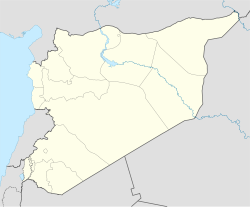- Mardikh
-
Mardikh
مرديخ— Village — Location in Syria Coordinates: 35°52′N 36°48′E / 35.867°N 36.8°E Country  Syria
SyriaGovernorate Idlib Governorate District Idlib District Area - Total 12.21 km2 (4.7 sq mi) Elevation 409 m (1,342 ft) Population (2008) - Total 3,400 Mardikh is a village in the Idlib Governorate of Syria. It is the nearest village to the famous historical site Ebla or "Tel Mardikh" located in the South East of Idlib. The village has approximately 3,400 inhabitants.
Overview
Every year, about 15,000 tourists visit the historical sight of Ebla which is most famous for the archive of 15,000 cuneiform tablets found there that date back to around 2250 BC. The majority of the population are occupied in construction. With regards to farming, its most important cultivated crops are cereals, legumes, cotton, potatoes, watermelons and cumin. The village covers a surface area of 1,221 hectares (4.71 sq mi) and has a primary and preparatory school, a mosque and a pharmacy that provides medical services to its inhabitants.[1]
References
Idlib Governorate Cities 

Towns and villages Armanaz · Al-Bawabiya · Binnish · Kafr Nabl · Khan Shaykhun · Ma'arrat Misrin · Mardikh · Qunaya · Salqin · Saraqib · SarminCoordinates: 35°48′40″N 36°47′26″E / 35.81111°N 36.79056°E
Categories:- Syria geography stubs
- Populated places in Idlib Governorate
Wikimedia Foundation. 2010.

